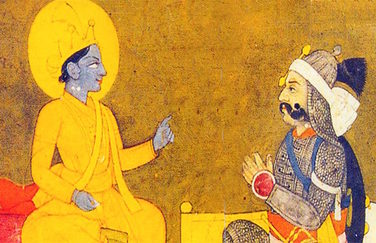BHAGAVAD GĪTĀ
Introduction

The Bhagavad Gītā, or the Lord’s Song, is one of the oldest and most comprehensive texts on Yoga. It is part of the Mahābhārata, the great Hindu epic that tells the story of Kṛṣṇa and the five sons of Paṇḍu. Kṛṣṇa is the incarnation of Viśṇu, the preserving aspect of Brahman. Kṛṣṇa is, therefore, aware of His oneness with the Absolute Reality and, in the Bhagavad Gītā, He is the voice of the Supreme Self.
The Lord comes to the world when righteousness declines and immorality surges in order to reestablish the path of Yoga. This ancient system has two aspects: the path of work for those who are still attached to the world and the path of knowledge for those who seek Self-realization. In the Bhagavad Gītā, complete devotion to God is emphasized in the path of Yoga. That is how one evolves from performing prescribed duties for personal reward to absorption into the Supreme Reality.
The Bhagavad Gītā has eighteen chapters, which can be divided into three sections. The first six chapters deal with the Self and the path to Self-realization. This part details the practices of discrimination, action, renunciation, knowledge, and meditation. Chapters seven through twelve focus on the nature of the Supreme and the importance of devotion; and the last six chapters cover the human condition and the qualities of nature.
The Lord comes to the world when righteousness declines and immorality surges in order to reestablish the path of Yoga. This ancient system has two aspects: the path of work for those who are still attached to the world and the path of knowledge for those who seek Self-realization. In the Bhagavad Gītā, complete devotion to God is emphasized in the path of Yoga. That is how one evolves from performing prescribed duties for personal reward to absorption into the Supreme Reality.
The Bhagavad Gītā has eighteen chapters, which can be divided into three sections. The first six chapters deal with the Self and the path to Self-realization. This part details the practices of discrimination, action, renunciation, knowledge, and meditation. Chapters seven through twelve focus on the nature of the Supreme and the importance of devotion; and the last six chapters cover the human condition and the qualities of nature.
Background
The Bhagavad Gītā takes place on the field of Kuru, where the armies of the sons of Pāṇḍu, known as the Pāṇḍavas, and the sons of Dhṛtarāṣṭra, known as the Kauravas, are about to clash. Pāṇḍu was the king of the Kuru Dynasty. His elder brother, Dhṛtarāṣṭra, being blind, was not eligible to be king; but, on Pāṇḍu’s sudden death, he assumed power until Pāṇḍu’s eldest son, Yudiṣṭhira, was ready to rule.
The Pāṇḍava Princes (Yudhiṣṭhira, Bhīma, Arjuna, Nakula, and Sahadeva) and their cousins were raised together in the royal city of Hāstinapura. However, the Kauravas became jealous of their more talented cousins and, when it was time for Yudiṣṭhira to inherit his father’s kingdom, Dhuryodhana, the elder Kaurava, made several attempts to kill or exile the Pāṇḍavas and usurp their kingdom. Finally, after all attempts to peacefully settle the matter failed, the two sides prepared for war.
That is where the Bhagavad Gītā begins.
The Pāṇḍava Princes (Yudhiṣṭhira, Bhīma, Arjuna, Nakula, and Sahadeva) and their cousins were raised together in the royal city of Hāstinapura. However, the Kauravas became jealous of their more talented cousins and, when it was time for Yudiṣṭhira to inherit his father’s kingdom, Dhuryodhana, the elder Kaurava, made several attempts to kill or exile the Pāṇḍavas and usurp their kingdom. Finally, after all attempts to peacefully settle the matter failed, the two sides prepared for war.
That is where the Bhagavad Gītā begins.
Go To Section 1

